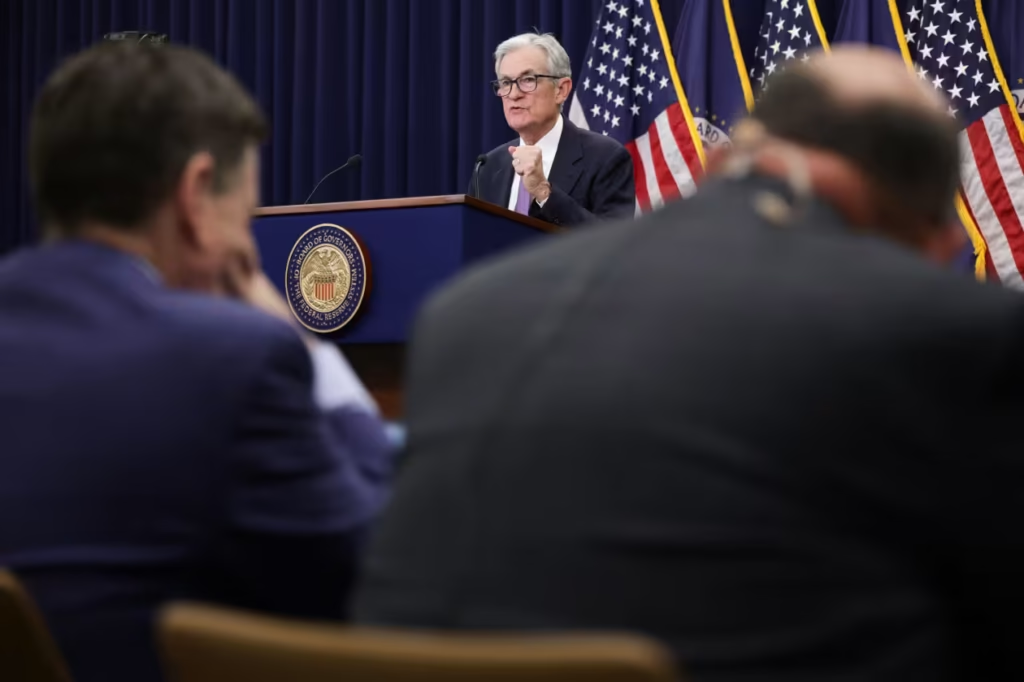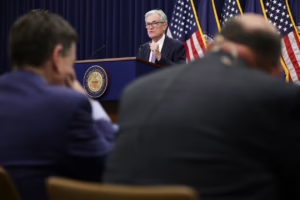Fed Chair Jerome Powell’s assessment that his colleagues had “strongly different views” about what to do in December and his caution that a rate cut at that meeting was “far from… a foregone conclusion” were the highlights of his news conference on Wednesday.
Derivative market traders reduced their expectations of a cut to 67% from 90% a day earlier after listening to Powell’s unprompted explanation regarding December.
The Fed did lower rates by a quarter-percentage point, as was to be expected, but the focus of the conversation and the market’s response was the expectation for the meeting on December 9–10.
According to Benson Durham, head of global policy at Piper Sandler, a December cut is now a “toss up.” There are economists on both sides of the dispute.
Deutsche Bank and BMO Capital Markets economists remain committed to their December rate decrease prediction.
If they get the government statistics, the Fed will ultimately cut, according to Luke Tilley, chief economist at Wilmington Trust. “I think the labor-market data will support a cut,” he stated.
According to Rick Reider, the chief investment officer of global fixed income at BlackRock Inc. and a candidate on President Donald Trump’s shortlist to succeed Powell, there is a greater likelihood that the Fed would forego a decrease in December.
Jonathan Millar, senior U.S. economist at Barclays, stated, “I get the sense the bar for cutting is probably higher than the market was expecting.” “It is not just about risk management, they would need more than that to warrant an additional cut,” he stated.
Powell also hinted that a lack of data would prompt the Fed to hesitate in December.
We simply don’t know what we’re going to get in terms of how that might impact December. We’ll have to wait and see how things work out, but if there’s a lot of ambiguity, that might be a reason to move cautiously,” Powell stated.
“If you’re driving in the fog, you slow down,” he stated.
The first two-way disagreement at a Fed meeting since 2019 also occurred on Wednesday.
Fed Governor Stephen Miran, who was on leave from the Trump White House, dissented in favor of a 50 basis point decrease, while Kansas City Fed President Jeff Schmid dissented in favor of keeping rates unchanged.
Powell observed that the central bank was deeply divided.
Saying that Powell has lost the committee’s backing is going too far, according to Diane Swonk, chief economist at KPMG.
“You should anticipate dissent at this time. “This is unlike anything we’ve seen since the 1970s,” Swonk stated.
According to her, the question of how the Fed should react when inflation is rising and the labor market is contracting is a valid one. While other Fed officials are more concerned about inflation, Powell is obviously in favor of further rate decreases.
“There is no slam-dunk answer here.” “Swonk” Furthermore, the economy is giving conflicting signals and the lack of data makes things unclear.
For example, she added, the stock market is booming while most Americans are dissatisfied with the state of the economy and concerned about inflation and job security. Additionally, despite modest job growth, consumer spending was robust in the third quarter.
“The growth numbers suggest we’re nowhere near a recession, but we’re getting pretty close to a payroll recession, and that’s a fairly odd thing,” Swonk stated.





